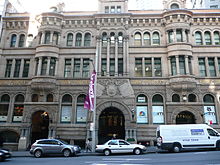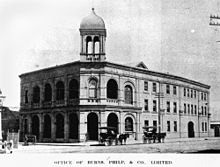| Revision as of 01:49, 6 June 2015 editDl2000 (talk | contribs)Autopatrolled, Extended confirmed users, New page reviewers, Pending changes reviewers, Rollbackers821,622 editsm en-AU← Previous edit | Revision as of 12:03, 25 August 2015 edit undoDavidcannon (talk | contribs)Administrators99,571 editsm clean up, typo(s) fixed: five week → five-week using AWBNext edit → | ||
| Line 6: | Line 6: | ||
| ==History== | ==History== | ||
| ], Queensland in 1901]] | ], Queensland in 1901]] | ||
| In April 1883 ] and ] began a trading partnership, originally named the "Burns, Philp & Company Limited".<ref> |
In April 1883 ] and ] began a trading partnership, originally named the "Burns, Philp & Company Limited".<ref>Douglas, N. and Douglas, N. (1996) "Tourism in the Pacific: Historical factors" in Hall, C.M. and Page, S.J. (eds.) ''Tourism in the Pacific: Issues and Cases'', London pp. 65-80</ref> They were the first company to offer tourism to New Guinea, in 1884, advertising the 'New Guinea Excursion Trip'.<ref>''Sydney Morning Herald'', 16 February 1884 in Douglas, N. (1994) "Electric Shadows in the South Seas: The Pacific Islands in film" in D. Aoki (ed.) ''Moving Images of the Pacific Islands: A Guide to Films and Video'', Center for Pacific Island Studies: Honolulu, p. 40</ref> This consisted of a five-week trip from ] and has been described as the "official beginning of tourist cruises in the South Pacific".<ref>Douglas, N. (1994) 'Electric Shadows in the South Seas: The Pacific Islands in film' in D. Aoki (ed.) ''Moving Images of the Pacific Islands: A Guide to Films and Video'', Center for Pacific Island Studies: Honolulu, p. 40</ref> The company later published a book titled ''Picturesque Travel''. Sir ] twice became ], while Sir ], became a member of the ] and founder/ benefactor of Burnside Presbyterian Homes for Children. | ||
| By 1914 the Burns, Philp Tourist Department was established, advertising tours on Lord Howe and Norfolk Island. Acquisition of the Port Moresby Hotel occurred in the same year, with the Papua Hotel purchased some years later. Burns, Philp "maintained a near monopoly on passenger services to Melanesia until the outbreak of the war in the Pacific".<ref> |
By 1914 the Burns, Philp Tourist Department was established, advertising tours on Lord Howe and Norfolk Island. Acquisition of the Port Moresby Hotel occurred in the same year, with the Papua Hotel purchased some years later. Burns, Philp "maintained a near monopoly on passenger services to Melanesia until the outbreak of the war in the Pacific".<ref>Douglas, N. and Douglas, N. (1996) "Tourism in the Pacific: Historical factors" in Hall, C.M. and Page, S.J. (eds.) ''Tourism in the Pacific: Issues and Cases'', London p. 27</ref> During this period the company had a dominant role in trade in the region distributing general merchandise and collecting ]. The war saw the British government take over some of the Burns, Philp fleet, and the vessel ''Macdui'' was sunk in Port Moresby in 1942 on its first voyage as a ].<ref>Buckley, K. and Klugman, K. (1983) ''The Australian Presence in the Pacific: Burns, Philp 1914-1946'', George Allen & Unwin: Sydney</ref> | ||
| ] | ] | ||
| Line 18: | Line 18: | ||
| ==Former Burns Philp Building== | ==Former Burns Philp Building== | ||
| The former Burns Philp Building in ], was built in 1901 to the design of ] of A.L. & G. McCredie & Anderson. |
The former Burns Philp Building in ], was built in 1901 to the design of ] of A.L. & G. McCredie & Anderson.<ref></ref> | ||
| ==References== | ==References== | ||
| Line 27: | Line 27: | ||
| *{{cite web |url=http://www.merchant-navy-ships.com/index.php?id=3,0,0,1,0,0 |title=Burns Philip |last1=Wylie |first1=Ron (Steve) |date= |website=The Australian Merchant Navy |publisher= |accessdate=21 March 2008 |archiveurl=https://web.archive.org/web/20120621025629/http://www.merchant-navy-ships.com/burns-philp/ |archivedate=21 June 2012}} | *{{cite web |url=http://www.merchant-navy-ships.com/index.php?id=3,0,0,1,0,0 |title=Burns Philip |last1=Wylie |first1=Ron (Steve) |date= |website=The Australian Merchant Navy |publisher= |accessdate=21 March 2008 |archiveurl=https://web.archive.org/web/20120621025629/http://www.merchant-navy-ships.com/burns-philp/ |archivedate=21 June 2012}} | ||
| {{ |
{{Primary sources|date=January 2007}} | ||
| ] | ] | ||
Revision as of 12:03, 25 August 2015

Burns Philp (properly Burns, Philp & Co, Limited) was once a major Australian shipping line and merchant that operated in the South Pacific. In later years the company was a major player in the food manufacturing business. Since its delisting from the Australian Stock Exchange in December 2006 and the subsequent sale of its assets, the company has mainly become a cashed up shell company. It is wholly owned by Graeme Hart's Rank Group.
History

In April 1883 James Burns and Robert Philp began a trading partnership, originally named the "Burns, Philp & Company Limited". They were the first company to offer tourism to New Guinea, in 1884, advertising the 'New Guinea Excursion Trip'. This consisted of a five-week trip from Thursday Island and has been described as the "official beginning of tourist cruises in the South Pacific". The company later published a book titled Picturesque Travel. Sir Robert Philp twice became Premier of Queensland, while Sir James Burns, became a member of the Legislative Council of New South Wales and founder/ benefactor of Burnside Presbyterian Homes for Children.
By 1914 the Burns, Philp Tourist Department was established, advertising tours on Lord Howe and Norfolk Island. Acquisition of the Port Moresby Hotel occurred in the same year, with the Papua Hotel purchased some years later. Burns, Philp "maintained a near monopoly on passenger services to Melanesia until the outbreak of the war in the Pacific". During this period the company had a dominant role in trade in the region distributing general merchandise and collecting copra. The war saw the British government take over some of the Burns, Philp fleet, and the vessel Macdui was sunk in Port Moresby in 1942 on its first voyage as a troopship.

Burns, Philp was once involved in the production and distribution of food ingredients and consumer branded food, beverage and related products. The Group operated internationally, with leading products and brands enjoying significant market shares in each of its principal markets. Its product ranges included packaged bread and other baked goods, snack foods, breakfast cereals, edible oils, and meal components. One of the most significant subsidiaries of the business in terms of profit was Goodman Fielder, Australasia’s largest baker, which was floated in an IPO (initial public offering). In 2007 Burns, Philp sold its remaining 20% stake in Goodman Fielder for NZ$676m.
Since 1997 New Zealand businessman Graeme Hart has had an interest in Burns, Philp. He has been on the Board of Directors since 1997 and Chairman since 2004.
In December 2006 Hart acquired the remaining 42% of Burns, Philp he didn't already own and the company was delisted on 20 December 2006. After the sale of its yeast and spices business to UK firm Associated British Foods, Uncle Toby's to Nestlé for NZ$1.1bn, Bluebird Foods to PepsiCo for NZ$245m, and its NZ$676m 20% stake in Goodman Fielder the company became largely a cashed up shell. Burns, Philp is wholly owned by Hart's private investment company Rank Group Limited.
Former Burns Philp Building
The former Burns Philp Building in Bridge Street, Sydney, was built in 1901 to the design of Arthur Anderson (architect) of A.L. & G. McCredie & Anderson.
References
- Douglas, N. and Douglas, N. (1996) "Tourism in the Pacific: Historical factors" in Hall, C.M. and Page, S.J. (eds.) Tourism in the Pacific: Issues and Cases, London pp. 65-80
- Sydney Morning Herald, 16 February 1884 in Douglas, N. (1994) "Electric Shadows in the South Seas: The Pacific Islands in film" in D. Aoki (ed.) Moving Images of the Pacific Islands: A Guide to Films and Video, Center for Pacific Island Studies: Honolulu, p. 40
- Douglas, N. (1994) 'Electric Shadows in the South Seas: The Pacific Islands in film' in D. Aoki (ed.) Moving Images of the Pacific Islands: A Guide to Films and Video, Center for Pacific Island Studies: Honolulu, p. 40
- Douglas, N. and Douglas, N. (1996) "Tourism in the Pacific: Historical factors" in Hall, C.M. and Page, S.J. (eds.) Tourism in the Pacific: Issues and Cases, London p. 27
- Buckley, K. and Klugman, K. (1983) The Australian Presence in the Pacific: Burns, Philp 1914-1946, George Allen & Unwin: Sydney
- NSW heritage Branch
Links
- Wylie, Ron (Steve). "Burns Philip". The Australian Merchant Navy. Archived from the original on 21 June 2012. Retrieved 21 March 2008.
| This article relies excessively on references to primary sources. Please improve this article by adding secondary or tertiary sources. Find sources: "Burns Philp" – news · newspapers · books · scholar · JSTOR (January 2007) (Learn how and when to remove this message) |